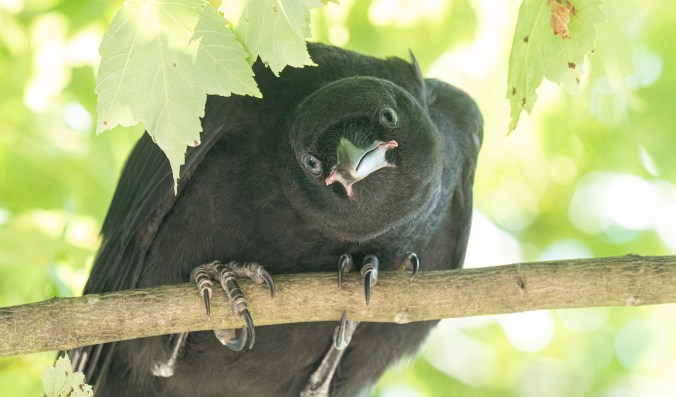
Crow babies are a particularly efficacious form of Crow Therapy. I know they’ve really helped to keep my spirits up during the long and strange summer of 2020.
Mabel, in particular, is having a busy time this year. Again.
She had three fledglings last year. Two survived the winter and have stayed with her and Gus to help with nesting season this year. Just as well, as she has another three to contend with this year!

Three babies. It’s a lot …
Normally she doesn’t come to the house, although our back yard used to “belong” to Mabel and the late lamented George Broken Beak. This summer, however, with three new mouths to feed, and the lure of a bird baths and an occasional sprinkler too strong to resist, she’s been coming back. There have been occasional spats with Marvin and Mavis, but Mabel’s clan have the numerical advantage, with four adult crows and the three rambunctious babies.

Young opera star in training
It started a couple of weeks ago when I was watering the katsura tree in front of the house and it turned into an impromptu corvid version of Splashdown Park.


Enjoying a nice cooling mist.

Learning how to sit with beak open to release heat on those hot summer days.
The triplets first fledged in around mid-July. Most birds don’t indulge the youngsters for nearly such a long time period as crow parents. The babies of smaller birds, like sparrows and finches, are expected to fend for themselves after a few short weeks. Their parents are usually keen to try and fit in a second round of nesting before the season ends, so it’s a short but intensive course on necessary survival skills, and then “good luck and off you go.”
Young crows, however, can be heard, loudly begging for food all summer long and into early fall.

The parents will start refusing to feed them after a few weeks, insisting they learn to forage for their own grub — but they do let the goofy youngsters hang around all summer — and often, as in Mabel and Gus’s case, right into the following year and beyond.

Mabel enjoys a brief moment to herself.

Scientific studies seem to suggest that this extended period of time with mom and dad contributes to the braininess of crows. You can almost hear the mental cogs spinning in the young crows’ brains as they gradually start to figure out the big new world around them.
Some things — like “is foliage a good snack?” — they just have to work out for themselves.


But a lot of the time, you can see them watching intently to see what mom or dad will do in a given situation — and carefully storing that information away for future reference.

I’ve had such fun watching Mabel’s babies this summer, I’m working on prints from some of the pictures.

Bedraggled
I also had some buttons made from these new images, plus one of Mabel and a fledgling last year (The Art of Parenting) and I’m mailing them out, in random fashion, with all current orders from my shop.
I’m not sure what it is that I like so much about buttons. I think it reminds me of the thrill of getting a free badge with one of my comics in England, back when I was a fledgling, many years ago.

__________________________________________________________________________________________
© junehunterimages, 2020. Unauthorized use and/or duplication of this material without express and written permission from this blog’s author and/or owner is strictly prohibited. Excerpts and links may be used, provided that full and clear credit is given to junehunterimages with appropriate and specific direction to the original content.


















